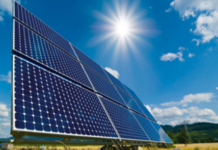
AGRICULTURAL development schemes for the next fiscal year will include new initiatives to facilitate a greater use of solar energy on farms and fields with active financial support of banks.
The Sindh government is in talks with at least two foreign companies to explore new ways of harnessing solar power. And its planning and development department has been working on modalities of public-private partnership projects in this regard. “The USAID partnership with Pakistani banks (for clean energy project financing) is one of the many funding sources we can rely on. Besides, ADB has also agreed to partly fund such projects. In the next budget some projects will roll out,” a senior Sindh government official told this writer.
Late last year, the USAID signed $88m funding agreement with five banks in Pakistan (HBL, MCB Bank, Faysal Bank, Meezan and JS Bank) to help finance establishment of small-scale clean energy projects.
In Punjab, the provincial government is set to re-launch, with the help of some foreign fund providers, an old scheme to convert hundreds of thousands of conventional tube wells on solar power. The ongoing scheme of selling solar-powered tube wells at subsidised rates will also continue.
In the last five years, solar panels’ use has been growing in rural areas, both at households and on farms and fields. But a couple of things keep the growth of solar energy limited
The KP government has also announced a similar plan. The provincial chief minister informed media some weeks ago that his government was in talks with the World Bank to seek funds for farmers who are willing to replace their electricity-fed tube wells with solar-powered tube wells.
And, Balochistan government’s negotiations with Canada for setting up solar power plants of 50MW in 20 districts are progressing well, officials say.
In the last five years, solar panels’ use has been growing in rural areas, both at households and on farms and fields. But a couple of things keep growth of solar energy limited.
Though fully furbished solar panels and their components remain exempt from import duty, their sales in local markets are not picking up fast enough to make an immediate impact on agriculture.
Flooding of low-quality imported solar panels in 2012 under an official support scheme in Sindh scared many farmers who had then installed these panels at their farms.
But for majority of those who use solar panels for running tube wells or powering wheat threshers or fodder cutters, it is fast becoming a reliable mode of power connection, growers say.
An official of Sindh agriculture department told this writer that producing solar energy through solar panels has limited benefits and “if the province wants to let agriculture go solar at a rapid speed, introducing solar tower technology is a must.”
In this technology sunrays are allowed to beat down on a large surface area and both sunlight and the heat obtained during the process are used to produce electricity.
Under the State Bank’s refinance scheme announced in June last year, banks were to offer concessional loans for setting up solar power projects of 1MW to 50MW (or any other green energy project of similar capacity).
But bank executives say they have not seen much demand for small-sized solar power projects, adding that demand for financing 50MW solar power project, too, is coming mostly from provincial governments or large companies.
Two groups of young farmers-cum-entrepreneurs from Hyderabad and Umerkot told this writer that their requests for funding solar power projects of 1MW each are not being entertained by local banks. “Bankers want to know whether we’ve been associated with a solar power project in the past.
When we say we are going to borrow money to set up our first ever project, they refuse to listen to us any further,” laments one of the group members, an electrical engineer by profession who is now seeking fund from a foreign NGO.
Despite little official support which remains limited to subsidies on solar-powered tube wells, our agriculture sector is slowly going solar. Growers in Sindh now routinely use solar panels in tunnel farming and poultry farming. Besides small silos are also being lighted with solar LED lights.
In Balochistan, irrigation-scale water wells are being run on solar power. And, solar water heaters and solar UPS and inverters are not so uncommon in KP and northern areas. But all this is due mainly to imports. Local manufacturing is yet to take off.
Industry sources say some new initiatives to promote local manufacturing is on the cards Pakistan’s clean energy programme.
A USAID report on Pakistan’s alternative energy prepared in 2016 says solar energy programme has enough potential that can be harnessed with a mix of right policy measures and foreign and local entrepreneurs’ participants.
Source: https://www.dawn.com


















